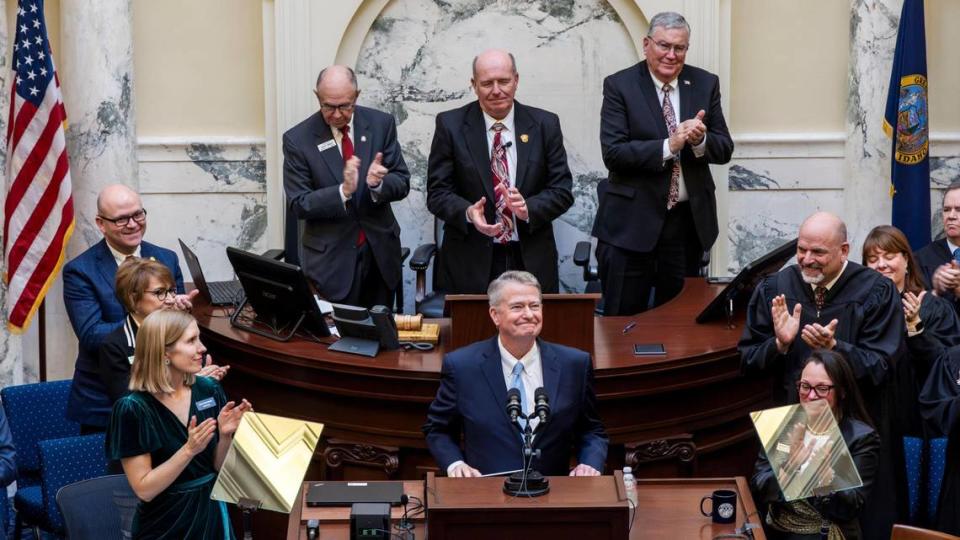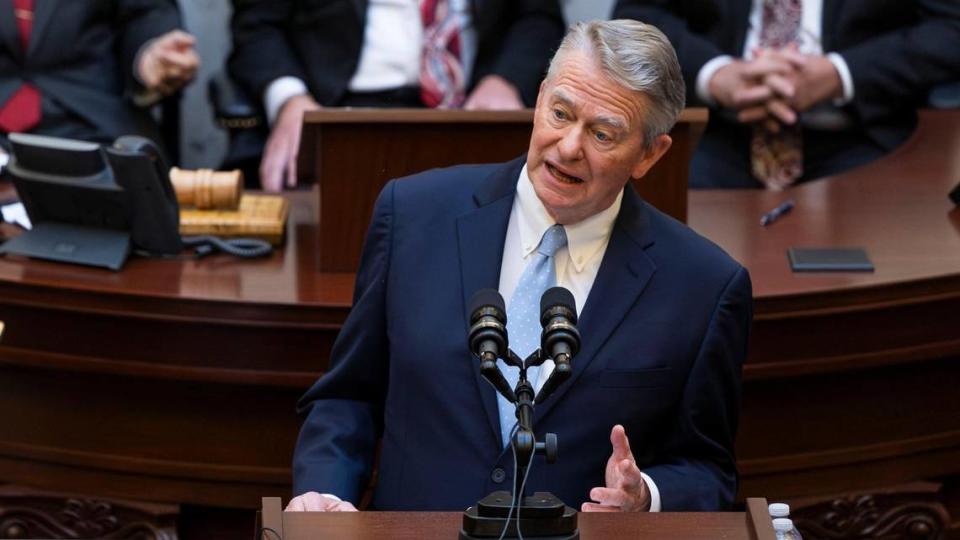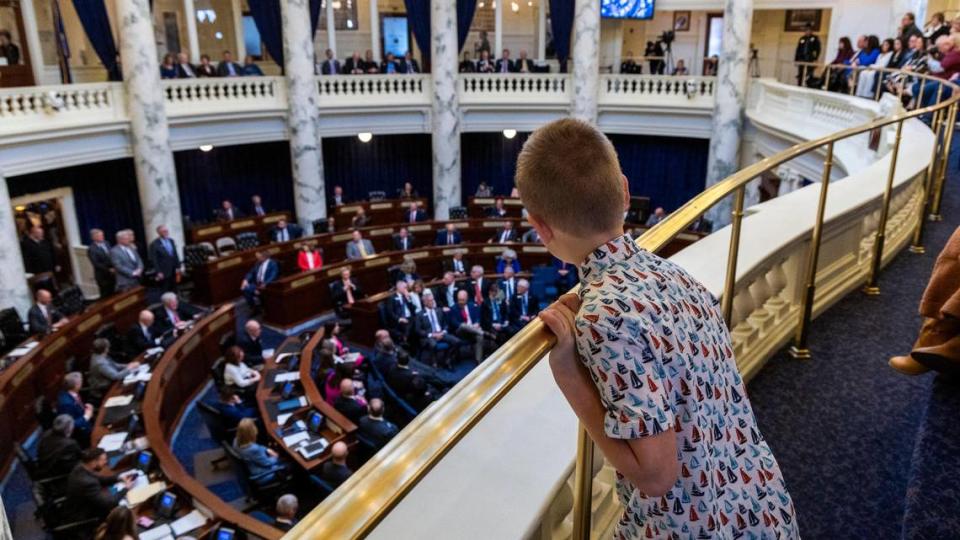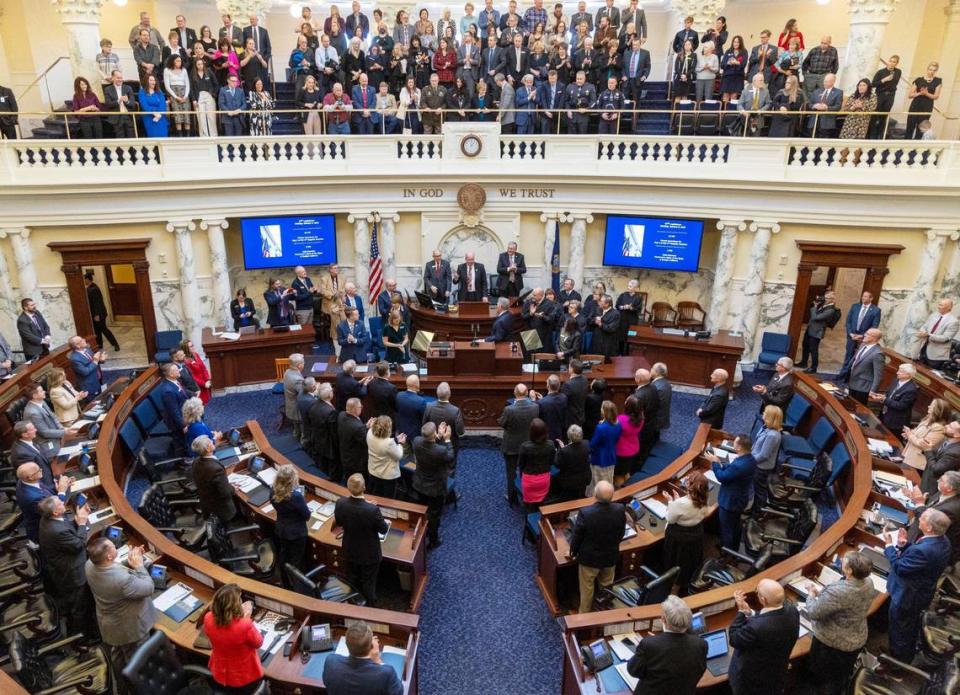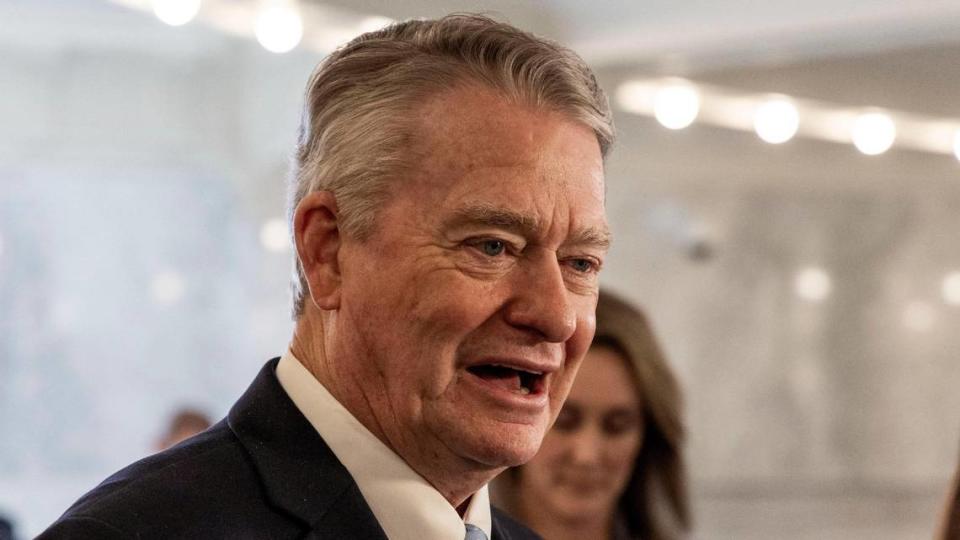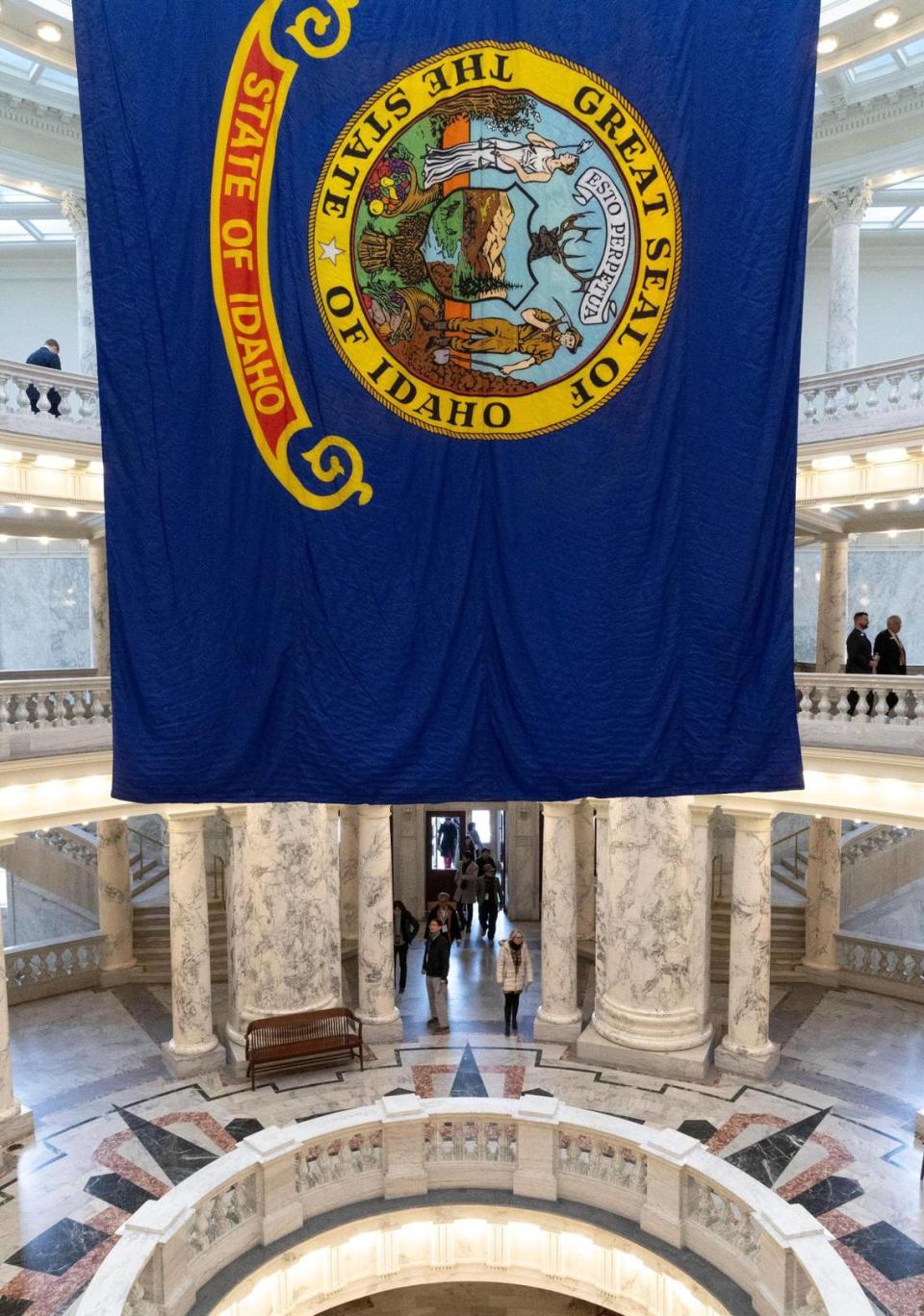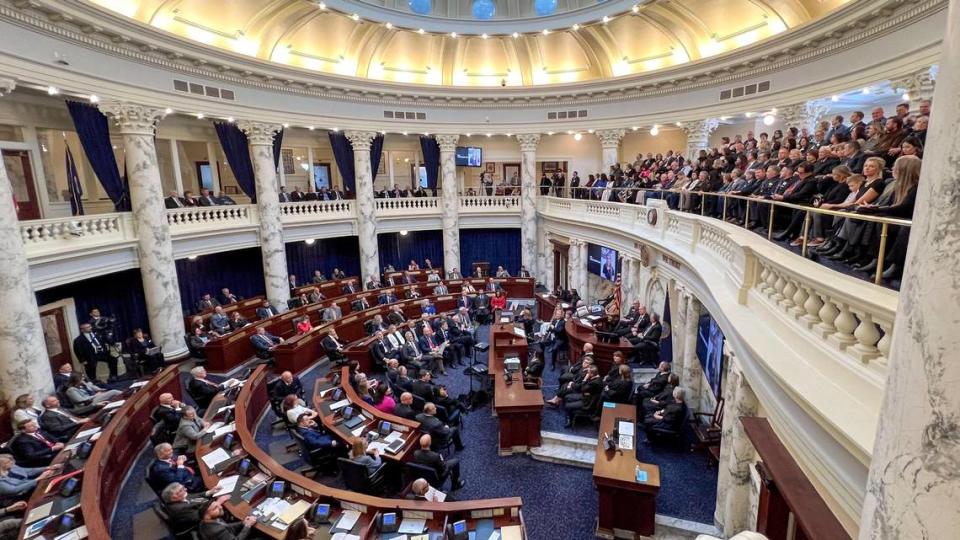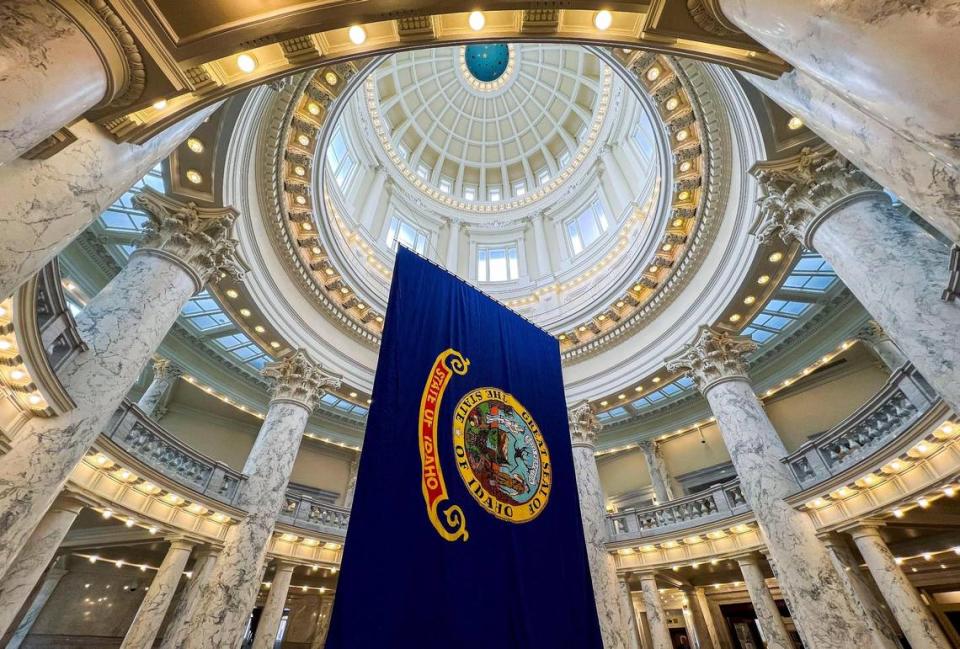‘We can do better.’ Idaho Gov. Little announces $2 billion in funding for school buildings
- Oops!Something went wrong.Please try again later.
- Oops!Something went wrong.Please try again later.
Idaho Gov. Brad Little on Monday announced a $2 billion investment in public schools over the next 10 years, a large contribution aimed at shoring up dilapidated infrastructure at schools across the state.
Little said the investment, which he announced in his State of the State address, provides property tax relief that would also provide school districts with the ability to repair and replace their school buildings, citing reporting from the Idaho Statesman and ProPublica. Local school districts have long struggled to fix their dilapidated, aging school buildings, in part because of the high two-thirds voter approval threshold that school bonds require. Schools face leaking roofs, collapsing ceilings from water damage and failing plumbing, the investigation from the Statesman and ProPublica found.
Idaho consistently ranks among the bottom nationally in per-student and school infrastructure funding.
“We’ve all seen the pictures and videos of some Idaho schools that are neglected — crumbling, leaking, falling apart,” Little said. “In one school I visited, raw sewage is seeping into a space under the cafeteria. Folks, we can do better.”
“As elected leaders, it is not just our constitutional obligation but our moral obligation as well to prioritize and strengthen public schools,” Little added.
Education has been a focus of Little’s since he became governor in 2019. The state increased school funding by 16.4% last year and added $410 million in tax revenue funding for schools in 2022.
Little’s budget director, Alex Adams, told reporters Monday that he hopes to raise a $1 billion bond, which would be distributed to school districts around the state by a to-be-determined formula. The money could be used for school expansions or major renovations, Adams said. The other $1 billion would come from state sales tax revenue, with $125 million per year for construction and $75 million for maintenance over the next 10 years.
Adams said the governor’s office expects the specifics of the school funding plan to be sorted out during the legislative session.
“We’re the first to acknowledge that we’re not coming in and saying, ‘This is the plan,’” he said. “We’re coming to the Legislature, saying, ‘Let’s work together.’”
Some lawmakers remain skeptical of the plan. House Speaker Mike Moyle, R-Star, told reporters Monday that lawmakers are concerned about the governor’s increased spending and the use of the state’s sales tax revenue.
“That concerns me,” he said. “It puts the state in a bad place going forward.”
Little’s proposed investment also includes $75 million for a program providing state education grants, known as Idaho Launch, that gives money to graduating high school students who enroll in in-demand job training — a program lawmakers, including Moyle, have remained critical of.
Idaho Republican Party Chairwoman Dorothy Moon, in a statement after Little’s speech, said she was “hoping to hear him promote smaller government and fiscal responsibility,” and was “left mostly disappointed.”
Meanwhile, Democratic lawmakers, who make up less than a fifth of the Legislature, said they supported the governor’s new education funding but still consider it insufficient.
“The facilities money that the governor is putting forward is bare bones,” said Minority Leader Ilana Rubel, D-Boise. “What he’s talking about is $1 billion over 10 years. We need $1 billion today,” adding that the funds do not include new schools or expansions that may need to be built.
New school funding amid school choice debate
Little’s proposed injection of funding into Idaho’s public schools comes as lawmakers in the Legislature are debating ways to use public funds to help residents pay for private schools or home-schooling.
A group of lawmakers proposed offering up to $5,000 in tax rebates to parents who choose not to send their children to public schools this month.
During his speech, Little said he supports “expanding school choice” in ways that do “not draw resources away from our public schools.” He told reporters afterward that he would have concerns about “anything that significantly detracts from longterm, ongoing funding” for public education.
Some other states have already implemented rebates or education savings accounts, also known as school vouchers. Teachers unions and public school advocates have largely opposed such measures over concerns that they would decrease funding for public schools.
“This policy is not about helping kids who need it, it’s about siphoning funds from public schools in order to provide a massive giveaway for private-school families,” Reclaim Idaho, an advocacy group that supports higher public school funding, said in a news release about the tax rebate proposal. Reclaim Idaho noted that a large majority of voucher funding in states with existing programs has gone to students already enrolled in public schools.
Universal voucher programs in some other states have quickly risen in costs, like in Arizona, where the governor projects the program could cost the state $944 million. The recently proposed bill in Idaho would be capped at $50 million, though lawmakers said they would be open to conversations about costs in the years to come.
House Speaker Mike Moyle, R-Star, told reporters after Little’s speech that he thinks it would be feasible to pass new school infrastructure funding and a school choice bill at the same time.
“If it’s done right, I think we can get both done,” he said.
Little proposes mental health center, social media regulation
Much of Little’s address was a recorded video, in which he and other state leaders, including Republican U.S. Rep. Russ Fulcher, talked about their infrastructure spending, school maintenance and tax cuts. His speech also mentioned a slew of other proposals for the year, such as money for university infrastructure, transportation and a mental health facility.
Infrastructure remains a priority for Little, he said. After funding bridge improvements with $400 million over the previous two years, Little hopes the Legislature will appropriate $200 million more to finish repairing the state’s 900 bridges that “have been rated poor or predate the Moon landing,” he said.
The governor said he wants to issue an $800 million bond for new transportation projects.
During his speech, Little touted Idaho being “the first state to ban critical race theory in our schools” and signing “a bill defending integrity in women’s sports,” in reference to a bill banning transgender women and girls from competing in school athletics.
Little’s proposed budget included $25 million for a 26-bed mental health center for incarcerated people. The Idaho Department of Correction would run the center, while the Idaho Department of Health and Welfare would run the services inside. The announcement followed an investigation by ProPublica, which reported that Idaho is one of the remaining states to imprison people who are deemed “dangerously mentally ill,” because the state has no hospital center for them, according to reporting in ProPublica.
Little said he also wants to implement legislation limiting the negative effects social media can have on children. He said he wants the Legislature to pass “meaningful reforms” to “better protect our children from the harms of social media.”
The governor also wants resources put towards a “Statewide Student Behavioral Health Initiative” to reduce suicides and to double funding for school advisors. In October and November, several teen suicides in the Boise area were reported in just a few weeks, sending shock waves through the Treasure Valley.
Legislative session to include abortion, library bills
Little’s speech steered clear of two controversial topics that lawmakers have said will likely crop up this legislative session: abortion and library bills.
Democratic leaders said they expect more bills related to libraries. A bill to allow residents to sue librarians for exposing children to “harmful” material narrowly failed to become law last year.
“There will be lots of culture war distractions and attacks on vulnerable minority communities, attacks on libraries, attacks on voting rights, etc.,” Rubel said.
Republican lawmakers said that in recent months they have been meeting with physicians and others to hear about impacts of the state’s abortion bans on women’s health.
“We want to make sure that physicians feel comfortable practicing in the state,” Majority Leader Megan Blanksma, R-Hammett, told reporters. “We’re just talking about standards of care,” adding that lawmakers are looking at physician “retention,” improving the foster care system and making adoption easier.
Maternal-fetal medicine doctors have reported leaving the state as a result of the state’s laws. Of the nine maternal fetal medicine specialists who practiced in Idaho before the state’s abortion ban took effect, only four remain, the Idaho Medical Association previously told the Idaho Statesman. In a survey conducted by the Idaho Coalition for Safe Reproductive Health Care, the vast majority of physicians said they’d reconsider plans to leave Idaho if a health exception was added to the state’s abortion laws.
“We don’t want to lose our docs, and we want them to feel comfortable here,” Blanksma said.
Abortion is illegal in nearly all cases. Though abortions are legal in cases to prevent the death of a pregnant patient, physicians have said it is unclear how the state’s exemptions would apply to a person whose health is seriously threatened by their pregnancy.
“This has become a fundamentally unsafe place,” Rubel said, “because if — god forbid — you have a complication, you are up the creek, and you better hope that your complication isn’t so urgent and severe that you don’t have 12 hours to hightail it out to Oregon.”
